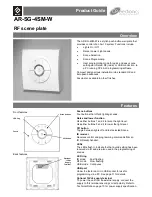
5
3. Connect the
Battery
first. Observe that the Battery Status LEDs blink in sequence
one time. Torque all the ProStar terminals tightly, but do not exceed 35 in-ib.
4. Connect the battery
Sense
. This is recommended, but not required, if the battery is
located more than 5 meters from the controller.
5. Connect the
Solar
. With sunlight, the green
Charging
LED will light.
6. Connect the
Load
. If there is a fault, the LEDs will begin blinking. Refer to section
4.0 of this manual to identify the fault.
7. Select the proper charging for the battery being used. Turn the rotary switch with a
screwdriver to the
Battery Type
printed on the label. The Battery Status LEDs will
blink 1, 2 or 3 times depending on the Battery Type selected.
8. For 12 or 24 volt systems, the ProStar will automatically select the system voltage. If
the system is 24 volts, first confirm that the battery is above 15.5 volts. The controller
selects 12 or 24 volts at start-up.
9. Observe the LEDs and digital meter (if provided) to confirm normal operation.
10. It is recommended that the system be properly grounded.
4.0 LED INDICATORS
The 4 LEDs in the lower label indicate system status and various faults. These functions are
described below.
CHARGING
(LED 1 – green)
ON:
battery charging during sunlight (always on during sunlight)
OFF:
normal during night (off during sunlight indicates solar reverse polarity or
overcurrent)
BATTERY STATUS
(LEDs 2 – 4)
GREEN: ON
indicates battery is near full charge
BLINKING
indicates PWM charging (regulation)
YELLOW: ON
indicates battery at middle capacity
RED:
BLINKING
indicates a low charge state and a low voltage load disconnect
(LVD) warning
ON
indicates the load has been disconnected (LVD)
SENSE
+
–
–
+
–
+
BATTERY
LOAD
PV
+
–
+
–
1
UP
TEMP. SENSOR
CHARGING
BATTERY STATUS
BLINK:
LOW
ON:
LVD
4
2
3
1
BATTERY
TYPE
1
–
GEL
2
–
SEALED
3
–
FLOODED
3
10
6
5
BATTERY
5
7
9



































